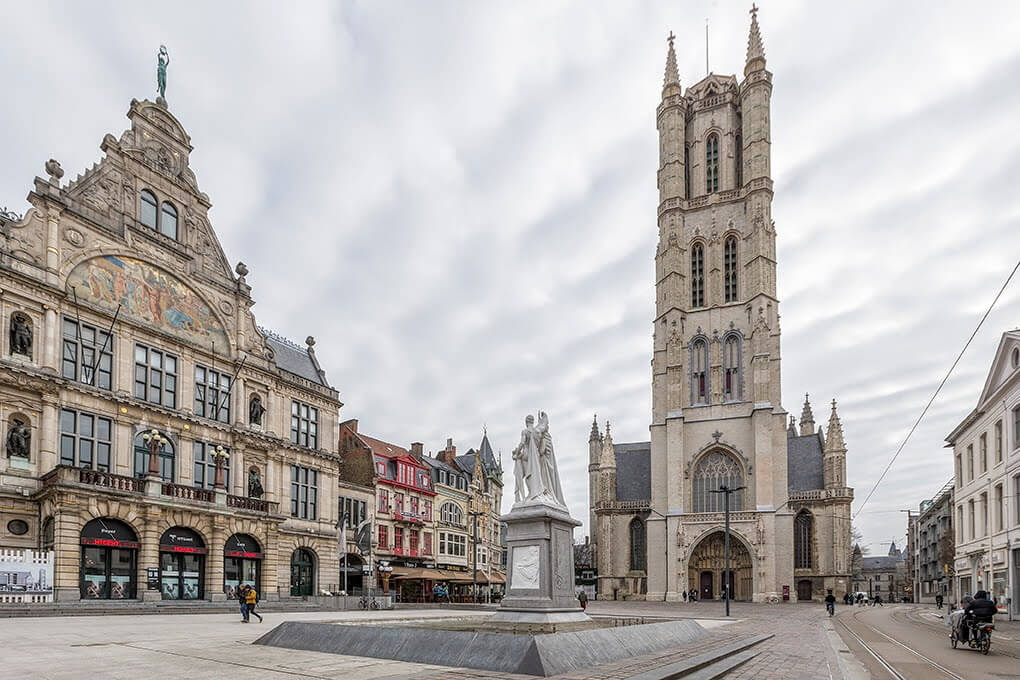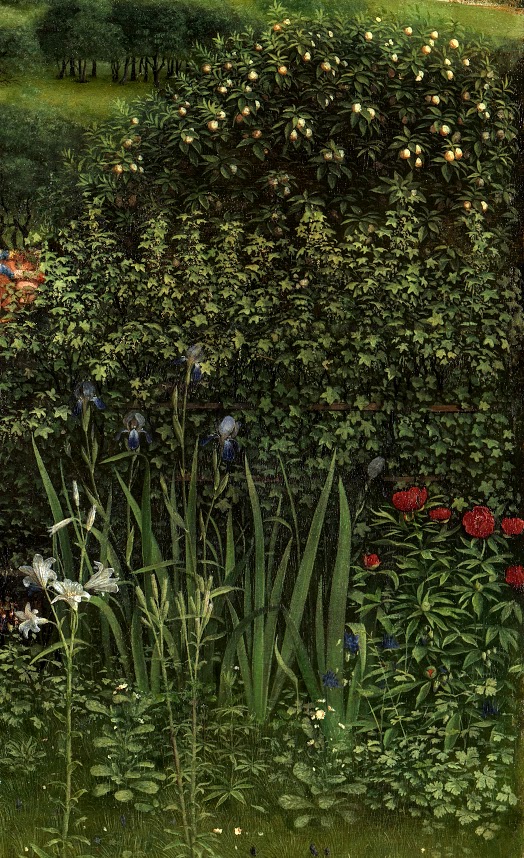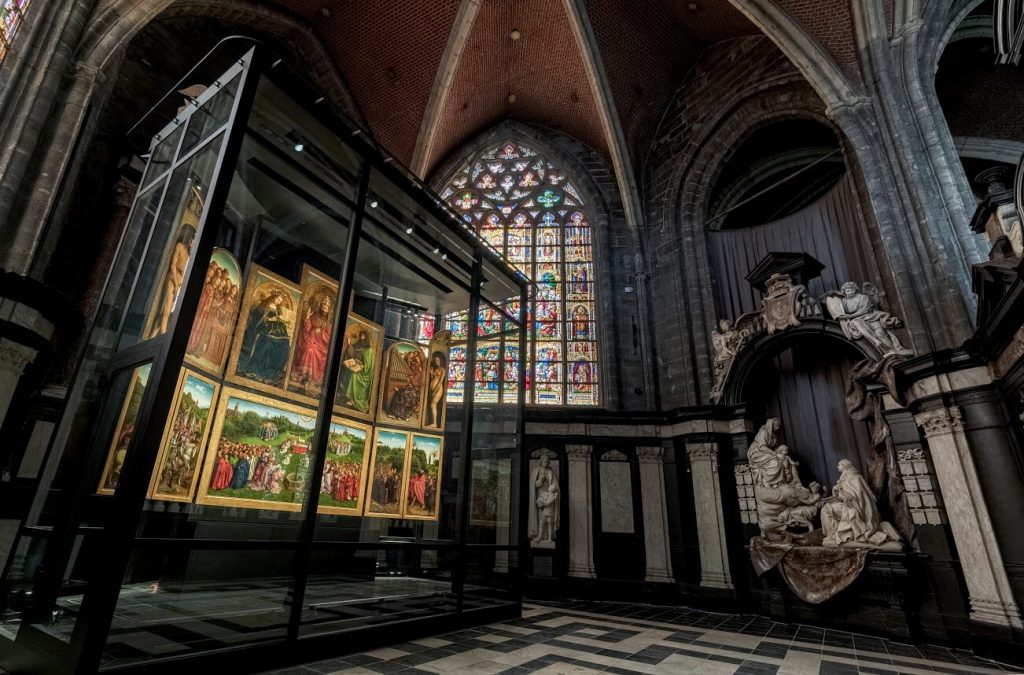Ghent Altarpiece is one of the most distinguished artworks in the world. It was made by one of the most famous Flemish masters, Jan van Eyck, six hundred years ago. Located in the Saint Bavo Cathedral in Ghent, it’s a must-see for anyone visiting that charming Belgian town.
Ghent Altarpiece
But why the Ghent Altarpiece is such a famous piece of art? And what is so special about it?
Who made the Ghent Altarpiece?
One of the reasons for its fame is the master painter who made it. Ghent Altarpiece was created by brothers Hubert and Jan van Eyck. Although art historians still argue about who painted what, most of them agree that Hubert designed it, while Jan did all the painting after his brother’s death.
Jan van Eyck is one of the most acclaimed painters in history because he truly revolutionized the art world. He improved oil painting, so it became one of the most popular painting techniques in the western world. He belongs to the international Gothic style. But, with his attention to details and usage of light, van Eyck is one of the predecessors of the Renaissance.
⤷ Read more: Virtual Museum Visit – Jan van Eyck at MSK Ghent
Why the Ghent Altarpiece was made?
During the 15th century, the Saint Bavo Cathedral was extensively renovated. To help with financing the renovation, wealthy citizens of Ghent contributed by commissioning chapels in it.
Some of them were Ghent’s mayor Joos Vijd and his wife, Elisabeth Borluut. Their chapel was accordingly named the Vijd Chapel. A wealthy couple commissioned a massive altar from Hubert van Eyck in the mid-1420s. He started working on it, but after his death, Hubert’s brother Jan van Eyck continued working on the altarpiece until 1432, when it was finished.
Commissioning these kinds of chapels and altars was a way to show social status. However, more importantly, it was believed to be a ticket to heaven for those affluent people. That’s why they are often presenting themselves among the saints or while praying at the paintings.
⤷ Read more: Weekend in Ghent
What is painted on Ghent Altarpiece?
Ghent Altarpiece has a complicated iconography with the main theme of heavenly apotheosis of man’s salvation by the sacrifice of Christ. The altarpiece consists of two registers of panels with wings that could be opened or closed.
When the panel is open, you can see God the Father with Virgin Mary and John the Baptist in the upper central panel. Next to them are the singing angles and pictures of Adam and Eve on the ends.
There is an Adoration of the Lamb of God, with many people gathering to celebrate it in the central lower panel.
When the Ghent Altarpiece is closed, you can see the Annunciation scene with Virgin Mary and the archangel Gabriel. In the top panels, prophets and sibyls are represented. At the very bottom, Saint John Evangelist and Saint John the Baptist, together with the donor couple, are painted.
Ghent Altarpiece was closed throughout most of the year. However, it was opened on the feast days when the inner, more colourful panels were displayed.
Ghent Altarpiece is among the most important works of art because Jan van Eyck painted nature in such a realistic way. It was presented like that for one of the first times in art history. It’s one of the first paintings on which you can see craters on the moon.
Even more, van Eyck had a diplomatic career as well and travelled a lot. He saw many exotic plants during his travels and depicted a lot of them on Ghent Altarpiece, too.
⤷ Read more: The best weekend trips to Flanders
Adventures of the Ghent Altarpiece
However, the last six hundred years weren’t very peaceful for the Ghent Altarpiece.
The first time it was removed from Saint Bavo Cathedral was in the 16th century during the Iconoclasm. Many religious art pieces were destroyed during that time. However, the Ghent Altarpiece was safely stored in town hall for the next twenty years and survived that way.
During the reign of Napoleon, it was taken to Paris and exhibited in Louvre. Luckily, it was only for a short time because it was returned to Ghent after the French defeat in the Waterloo battle in 1815.
The panels were disassembled after that. In 1821 wings were sold to the Prussian king and were on display in Berlin for a long time. At the same time, panels showing Adam and Eve were exhibited in a museum in Brussels. The rest of the panels were still in the cathedral. However, around that time, there was a fire in it that damaged the altarpiece.
After they occupied Belgium in World War One, German forces took the remaining panels and brought them to Germany. They were returned after the war, together with the ones from the Berlin museum.
A few years later, in 1934, two panels were stolen from Saint Bavo Cathedral. Saint John the Baptist was returned, but we’re still missing the Just Judges. There is a copy of it in its place in the Ghent Altarpiece today.
When the Second World War started, the plan was to hide the altarpiece. It was sent to France but soon captured by the Nazis. They took it and hide it with many other stolen art pieces in the salt mine in Germany during the war. However, it was found after it and brought back home to Belgium in October 1945.
⤷ TIP: The Monuments Man movie describes these events and the search for the stolen art during World War Two very well. So, if you want to learn more about these events, be sure to check it out.
Ghent Altarpiece Restauration
It was safely stored at its home, the Saint Bavo Cathedral, until 2012, when a complicated restoration started. Some coating was done in the later years, and the varnish changes its colour due to ageing. After examining the altarpiece, researchers decided to give it its original appearance back.
Ghent Altarpiece restoration mainly was finished at the end of 2019. So now, it looks the same as it did when Jan van Eyck painted it.
⤷ Read more: Locations linked to Vincent van Gogh in Belgium
Ghent Altarpiece Visitors Centre
The recently opened Visitors Centre at the Saint Bavo Cathedral in Ghent offers a deeper insight into van Eyck’s masterpiece. With the use of the augmented reality glasses, visitors can learn more about its style, painting technique, iconography and are getting an excellent overview of the masterpiece.
Once they learn about it, they could proceed to the new chapel where the famous piece of art is now exhibited. You can read more about it and book your online tickets at a link here.
The Ghent Altarpiece is without a doubt one of the best works of art in the world. Paying a visit to it while in Ghent should definitely be on your list of things to do in that beautiful Flemish town.













Comments
Post a Comment